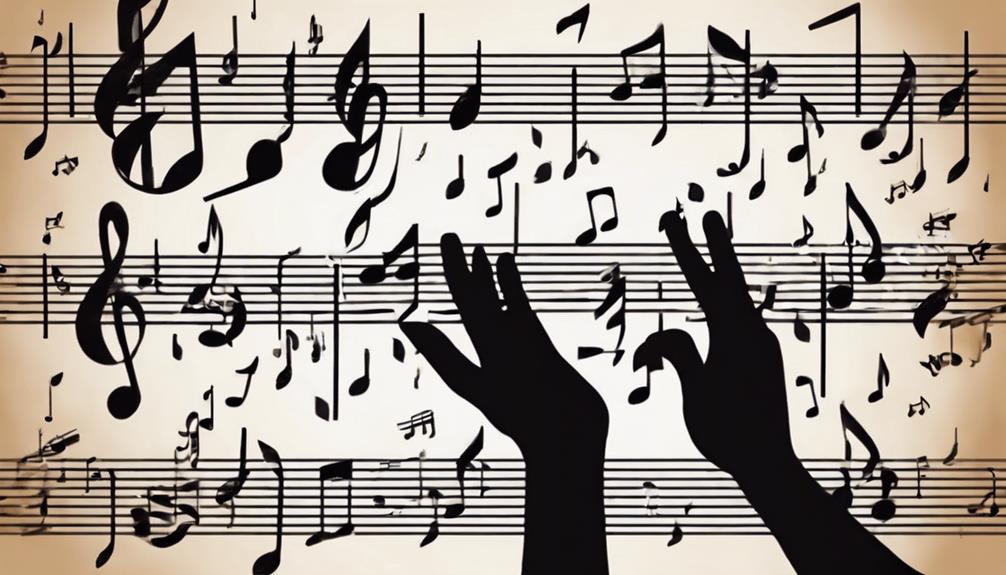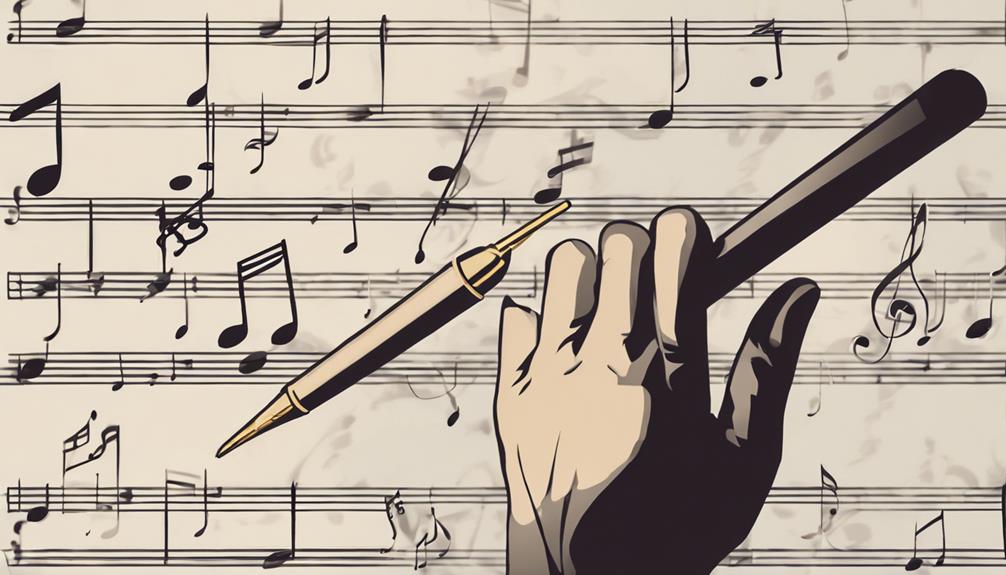No products in the cart.
Mastering music means delving deep into the heart of time signatures. These mathematical notations aren’t just numbers; they’re your keys to accessing rhythm and expression in your compositions. From the common beats of 4/4 to the waltz-like 3/4 and the energetic drive of 6/8, each signature crafts a unique rhythmic pattern. Tackling changes in time signature challenges you, enriching your performance. With a solid understanding, you’ll confidently navigate through complex rhythms and express musical ideas more compellingly. As you explore from common to compound and irregular meters, you’ll find your compositions gaining depth and intrigue, teasing curious minds with what lies ahead.
Contents
hide
Key Takeaways
- Time signatures shape the rhythmic structure and flow of music compositions.
- Mastering time signatures enhances musical communication and expressive capabilities.
- Understanding irregular and compound time signatures adds complexity and interest to music.
- Time signatures dictate the grouping and emphasis of beats, aiding in accurate performance.
- Knowledge of time signatures allows for creative rhythmic variations and unique musical expression.
Understanding Time Signatures
Diving into the world of music, it’s crucial you grasp how time signatures lay the foundation for a piece’s rhythmic heartbeat, guiding every beat and note played. These mathematical notations, represented by two numbers stacked one on top of the other, aren’t just figures but the backbone of a composition’s rhythmic flow. The top number tells you how many beats are in each measure, shaping the rhythmic patterns that you’ll encounter, while the bottom number reveals the note value that receives one beat, influencing how you perceive and perform each rhythm.
Understanding time signatures is pivotal for interpreting the rhythmic structure of a piece. Common time signatures like 4/4, 3/4, and 6/8 serve as the rhythmic foundation for countless genres, dictating how music moves and breathes. As you explore further into music, you’ll encounter time signature changes that challenge and enrich your playing or singing, propelling you into new territories of rhythmic complexity.
Mastering the concept of time signatures ensures you’re not just hitting notes in sequence but truly communicating through music. It’s about feeling the pulse of the piece, allowing you to move with it and express its emotional depth fully.
Reading Time Notation
To kick off your journey in reading time notation, let’s first get comfortable with identifying the basics of time signatures.
You’ll learn how the top and bottom numbers work together to dictate the beats per measure and the note value for each beat.
This foundational knowledge is key to understanding beats and measures, ensuring you can maintain rhythm and flow in your music performances.
Identifying Time Signature Basics
Understanding the basics of reading time signatures is essential, as they tell you how many beats are in each measure and what note value gets one beat. This foundational knowledge is the cornerstone of time signature analysis and rhythmic patterns exploration. By grasping these concepts, you’re equipped to:
- Accurately count and interpret the beats in each measure, ensuring your performance aligns with the intended rhythmic structure.
- Understand the bottom number’s significance, which guides you in identifying the note that represents one beat.
- Approach complex rhythms with confidence, as you’re now able to break them down into manageable, measurable units.
Time signatures are more than mere numbers; they’re your guide to exploring the vast world of music with precision and ease.
Understanding Beats and Measures
After grasping the basics of reading time signatures, you’ll find that mastering beats and measures further sharpens your ability to read and interpret music notation.
Beats in music serve as the backbone, giving a piece its underlying pulse or rhythm. These beats are organized into measures, or bars, which group them into distinct sets, making the rhythm visually apparent and easier to follow.
The organization of these measures is vital; each one is defined by a time signature that tells you exactly how many beats to expect and what kind of note gets one beat. By understanding this beat structure and measure organization, you’re better equipped to navigate complex rhythms, maintain consistent tempo, and convey musical ideas more effectively.
Common Time Signatures Explored
Exploring common time signatures offers a fascinating glimpse into how musicians craft the rhythm and mood of their compositions. Understanding these time signatures is essential for both rhythmic analysis and developing effective performance techniques.
Let’s delve into some of the most frequently encountered ones:
- 4/4 Time Signature: Often referred to as ‘common time,’ this signature is ubiquitous across various genres, including pop, rock, and jazz. Its straightforward nature—four quarter-note beats per measure—makes it a foundational rhythm for many musicians.
- 3/4 Time Signature: This signature evokes a distinct, waltz-like feel, with three quarter-note beats per measure. It’s a staple in ballads and waltzes, where its sway-like rhythm can evoke deep emotions and a sense of flow.
- 6/8 Time Signature: Providing a compound meter feel with six eighth-note beats per measure, 6/8 is commonly used to create a driving, energetic rhythm. It’s particularly favored in compositions where a sense of movement and excitement is desired.
Each time signature brings its unique flavor to compositions, influencing the overall emotion and creativity of a piece. They’re not just essential technicalities; they’re tools for expression, shaping how a piece of music feels to both the player and the listener.
Delving Into Irregular Meters
You’ve mastered the basics, but irregular meters like 5/4 time are where the rhythm truly gets interesting.
By breaking down complex rhythms, you’ll uncover how composers craft tension and intrigue in their music.
Let’s explore how these unconventional signatures can transform a piece, using examples like ‘Take Five‘ and ‘Money’ to guide us.
Exploring 5/4 Time
Diving into the world of irregular meters, let’s unravel the complexities of the 5/4 time signature, a rhythm that challenges and intrigues musicians across genres. This unique time signature, consisting of five beats per measure, introduces an unconventional and irregular feel to music, making it a favorite in progressive rock, jazz, and modern classical compositions.
Here are three critical aspects to take into account:
- Exploring phrasing nuances: The 5/4 time can be divided into 2 + 3 or 3 + 2 beat groupings, offering varied rhythmic expressions.
- Analyzing rhythmic tension: Composers leverage this time signature to craft tension and unexpected shifts in their music.
- Understanding its application: Songs like ‘Take Five’ and ‘Money’ exemplify how 5/4 time can create engaging, memorable rhythms.
Complex Rhythms Breakdown
Building on our understanding of 5/4 time, let’s now examine how irregular meters like 7/8 contribute to the rhythmic complexity in music. These meters mix different beat groupings, challenging you to navigate through shifting rhythmic accents for a dynamic performance. They’re not just technical hurdles; they’re opportunities for musical intrigue.
| Time Signature | Famous Piece | Impact on Music |
|---|---|---|
| 5/4 | “Take Five” | Adds a smooth, flowing rhythm |
| 7/4 | “Money” by Pink Floyd | Creates depth with off-beat patterns |
| 7/8 | “The Rite of Spring” | Introduces unpredictability |
| 9/8 | “Blue Rondo à la Turk” | Blends rhythmic variations |
| 11/8 | “Whipping Post” | Enhances performance dynamics |
Irregular meters captivate listeners, injecting songs with unexpected twists that keep everyone on their toes.
Exploring compound signatures, it’s important to grasp how they group notes into sets of three, offering a unique rhythmic flavor to music. This approach doesn’t just add complexity; it creates a tapestry of rhythmic intricacies that demand mastery in performance techniques. When you immerse yourself into the world of compound time signatures, you’re entering a domain where musical phrasing and dynamic accents play pivotal roles.
Here’s what you need to remember:
- Understand the Basics: Recognize that each beat in a compound time signature is divisible by three, unlike the simple time signatures. This foundation is essential for interpreting the music accurately.
- Identify the Signature: Whether it’s 6/8 with its two beats per measure or 9/8 with three, identifying the pattern helps in anticipating the flow and where to place emphasis.
- Practice with Purpose: Embrace exercises that focus on these signatures. This isn’t just about counting; it’s about feeling the triplets and incorporating them into your musical intuition.
Applying Time Signatures Creatively
Harnessing the power of time signatures creatively can transform ordinary musical pieces into compelling works of art. When you start experimenting with different meters, you’re not just playing with numbers; you’re exploring rhythmic variations that can greatly enhance your musical expression. Imagine the impact a well-placed 5/4 or 7/8 time signature could have on the mood and feel of your piece, adding layers of complexity and interest that captivate your listeners.
Understanding and mastering various time signatures is key. It’s not just about making music more complex; it’s about creating unique rhythmic patterns that define your compositions. This is where time signature fusion comes into play. By blending different meters, you can create unexpected rhythmic twists and innovative musical structures that set your work apart.
Frequently Asked Questions
What Is a Trick for Understanding Time Signatures?
A trick for grasping time signatures is to practice rhythmic patterns using a metronome. You’ll internalize the beat, making it easier to follow and perform music accurately. It’s all about feeling the rhythm!
How Do You Learn Time Signature in Music?
To learn time signatures in music, start by counting rhythms aloud and tapping your foot. Integrating metronome practice helps you maintain steady tempo, enhancing your rhythmic accuracy and overall musical performance.
How Do You Interpret the Time Signature?
To interpret the time signature, you’ll count beats to grasp its rhythm. Knowing a signature’s history helps understand its use. This approach guarantees you’re in sync with the music’s intended emotional and rhythmic flow.
How Important Is Time Signature in Music?
Time signature is essential in music as it shapes a piece’s rhythm, influencing its emotional impact and genre. It guides you in interpreting tempo, adding depth, and ensuring a cohesive musical experience.
Conclusion
Now that you’ve delved deep into the world of time signatures, you’re well on your way to mastering music. From reading time notation to exploring common and irregular meters, and even maneuvering through compound signatures, you’ve gained invaluable insights.
Remember, applying these time signatures creatively is where your unique sound shines. So, keep experimenting, and let your newfound knowledge guide your musical journey.
Here’s to your next masterpiece, crafted with precision and a deeper understanding of time in music.




